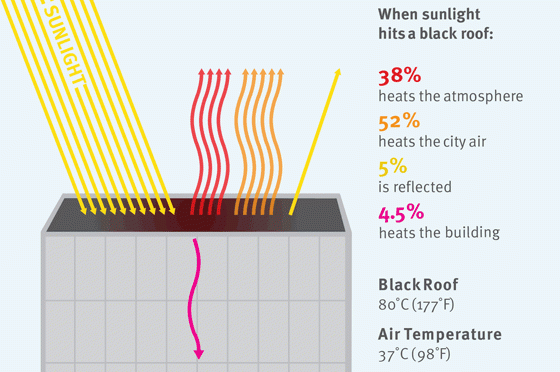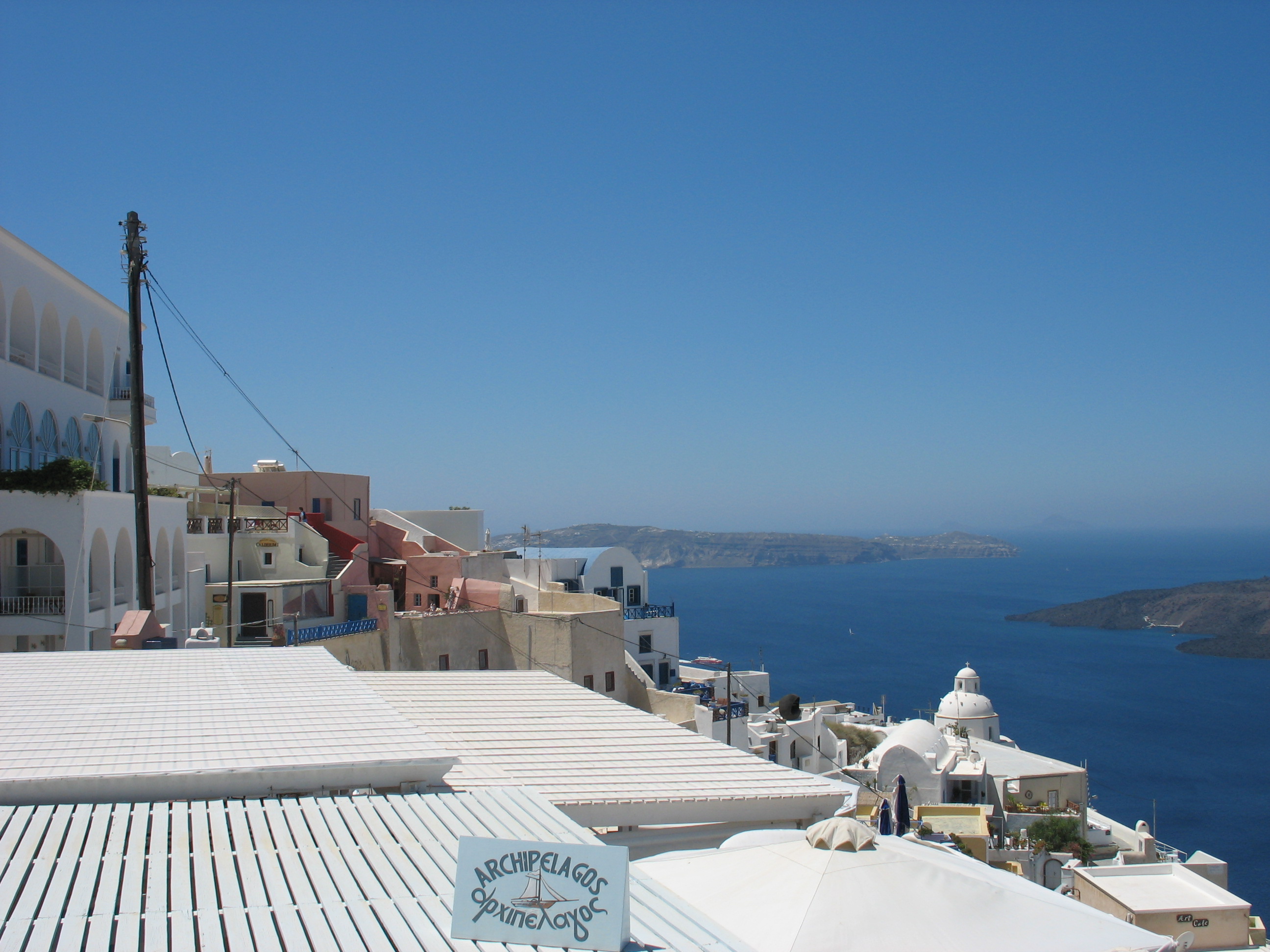As demand for cooling increases, so does electricity use, and costs for building owners and tenants.
Reflective roofs cool down your home or workplace by several degrees and save money by cutting cooling energy demand by up to 20%.
Light colored surfaces reflect more sunlight than dark ones do, turning less of the sun’s energy into heat. Increasing the reflectance of our buildings and paved surfaces—whether through white surfaces or reflective colored surfaces—can reduce the temperature of buildings, cities, and even the entire planet.

We have known for thousands of years that white or light colored surfaces reflect more of the sun’s light and make buildings cooler during warm seasons. The traditions of white buildings on the Greek Islands and white washed roofs in parts of India, Egypt, and Spain point to a popular understanding of this phenomenon going back to ancient times.

In today’s age of air-conditioning, cool roofs reduce the overall energy consumption of individual buildings by lowering the cooling demand. If the building is not air-conditioned, cool roofs can make the building considerably more comfortable. Studies undertaken over the last several decades on a variety of structures in cool and warm climates show that reflective roofs can reduce the air-conditioning demands of a building by up to 20%. You can dig into many of those studies on our Knowledge Base.
The energy-savings case for cool roofs in warm climates is clear. Widely adopted model building-code systems, ASHRAE and the IECC, address roof reflectivity. ASHRAE 90.1–1999 added a credit for highly reflective roofs with IECC allowing compliance via ASHRAE in 2003. ASHRAE 90.1–2010 added reflectivity requirements for new and replacement commercial roofs in Climate Zones 1 through 3. IECC added the same requirements in its 2012 version.
Reflective surfaces do not need to be white. Materials with high solar-reflectance can come in a range of colors, including many shades of gray and red. Hence the term “cool roofs”.
For more in-depth explanations, read A Practical Guide to Cool Roofs and Cool Pavements on our Toolkit site.
If all commercial buildings in the U.S. cities switched from dark to light roofs, we would save nearly $1 billion per year in avoided electricity use—money that could be reinvested to grow businesses and create jobs.
Based on an analysis by Lawrence Berkeley National Lab, reducing air-conditioning demands in the U.S. by installing cool roofs on 80% of the 2.58 billion square meters of commercial building conditioned roof area could save 10.4 terawatt hours of electricity and $735 million annually. More recent work shows that installing cool roofs delivers $1.25 in energy benefits per square foot of roof area ($13.59 per square meter). This adds up to economic benefits worth tens of millions of dollars and more in our cities. When other economic impacts are factored in, those benefits grow to over $5 per square foot ($54 per square meter)!
Cutting cooling energy use can substantially strengthen the finances of middle and lower income households where energy bills can be 10–20% or more of their monthly expenses.
Improving building comfort and efficiency has significant impacts on middle to low income families and communities of color. Research (Jesdale et al) shows that low-income, minority communities tend to experience the worst effects of heat due to a lack of vegetation, old housing stock, and other factors. In addition, the Natural Resources Defense Council finds that energy costs make up a substantial portion of monthly expenditures for low to middle income households—10% to over 50% in some places! As this Atlantic article points out, this trend is national in scope. Reducing these costs is a non-trivial way to improve the economics of our most vulnerable families while providing broader community benefits.
A program in Philadelphia found that applying a cool roof on rowhouse roofs occupied by residents without air conditioning found 5°F (2.8°C) reductions in air temperatures in the upstairs bedroom.
Almost all of the country enjoy net energy and energy cost savings when a cool surface is installed, even in cool northern climates.
Many people wonder how cool surfaces deliver net energy benefits in northern climates that experience cold winters and warm to hot summers (Climate Zones 4 through 8). Do reflective surfaces remain beneficial as the long cold weather heating season kicks in? The same properties that allow reflective roofs to keep buildings cooler in the summer may also cause them to make buildings colder in the winter. Theoretically, buildings with cool roofs could require more energy to reach a comfortable temperature in winter—a consequence known as the “winter heating penalty.” Furthermore, building codes tend to require more roof insulation in colder climates than warmer climates, potentially reducing the energy-efficiency benefits of roof surface reflectivity.
Big Gains in Summer with Little Losses in Winter
The “winter heating penalty” and the impact of insulation are considerations when installing reflective roofs in some cold climates, but their negative effects are often greatly exaggerated. There are several reasons why cooling savings outpaces heating use increases.
- The sun is generally at a lower angle and days are shorter in winter months than summer months. In fact, in northern locations winter solar energy is only 20 to 35% as intense as what is experienced in summer months, which means the sun has a reduced impact on roof surface temperature during the winter.
- Heating loads and expenditures are typically more pronounced in evenings, whereas the benefit of a darker roof in winter is mostly realized during daylight hours.
- Many commercial buildings require space cooling all year because of human activity or equipment usage, thereby negating the little—if any—heating benefit achieved by a dark roof.
Insulation and Reflectivity: Better Together
Another argument often heard against reflective roofing in cold climates is that buildings in northern climates tend to have higher levels of roof insulation that reduce or negate the energy-savings impact of roof surface color. A new field study and model analysis of black and white roof membranes over various levels of insulation by the City University of New York, Princeton University, and Princeton Plasma Physics Lab, both of Princeton, N.J., clearly rebuts the “insulation versus reflectivity” tradeoff.
The papers highlight the interconnected role of reflectivity and insulation in roofing systems. Their studies, published in Energy and Buildings, found that reflectivity is the variable that minimizes heat flux during the summer and that insulation levels are the driving variable during winter. (See “The joint influence of albedo and insulation on roof performance: An observational study”, 2015, Energy and Buildings, Volume 93, pages 249–258, or bit.ly/2aSfeFO, and “The joint influence of albedo and insulation on roof performance: A modeling study”, 2015, Energy and Buildings, Volume 102, pages 317–327, or bit.ly/2aYVdeR.) In other words, to be a high-performance roofing system that minimizes heat gain in the summer and heat loss in the winter, you need both insulation and a highly reflective roof surface.